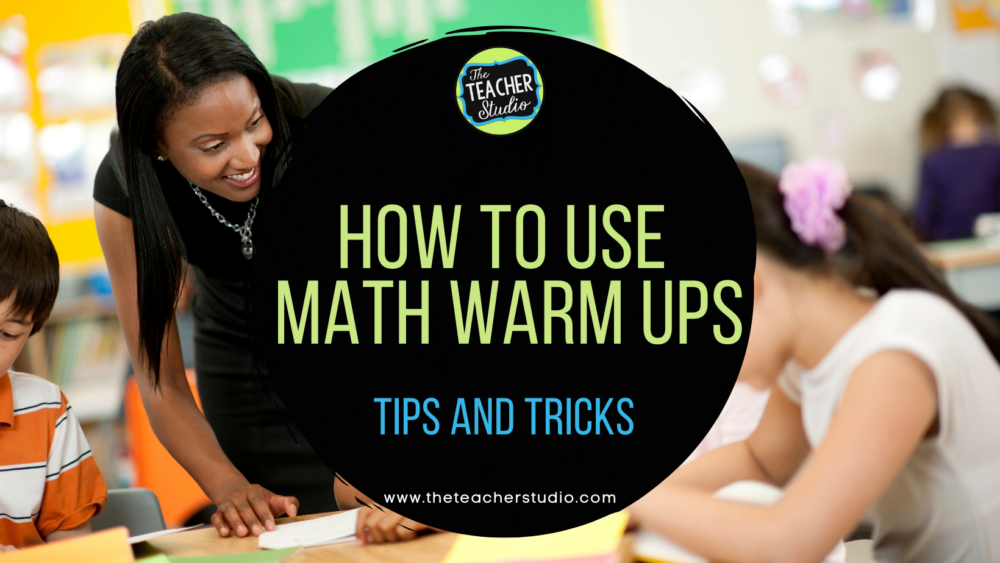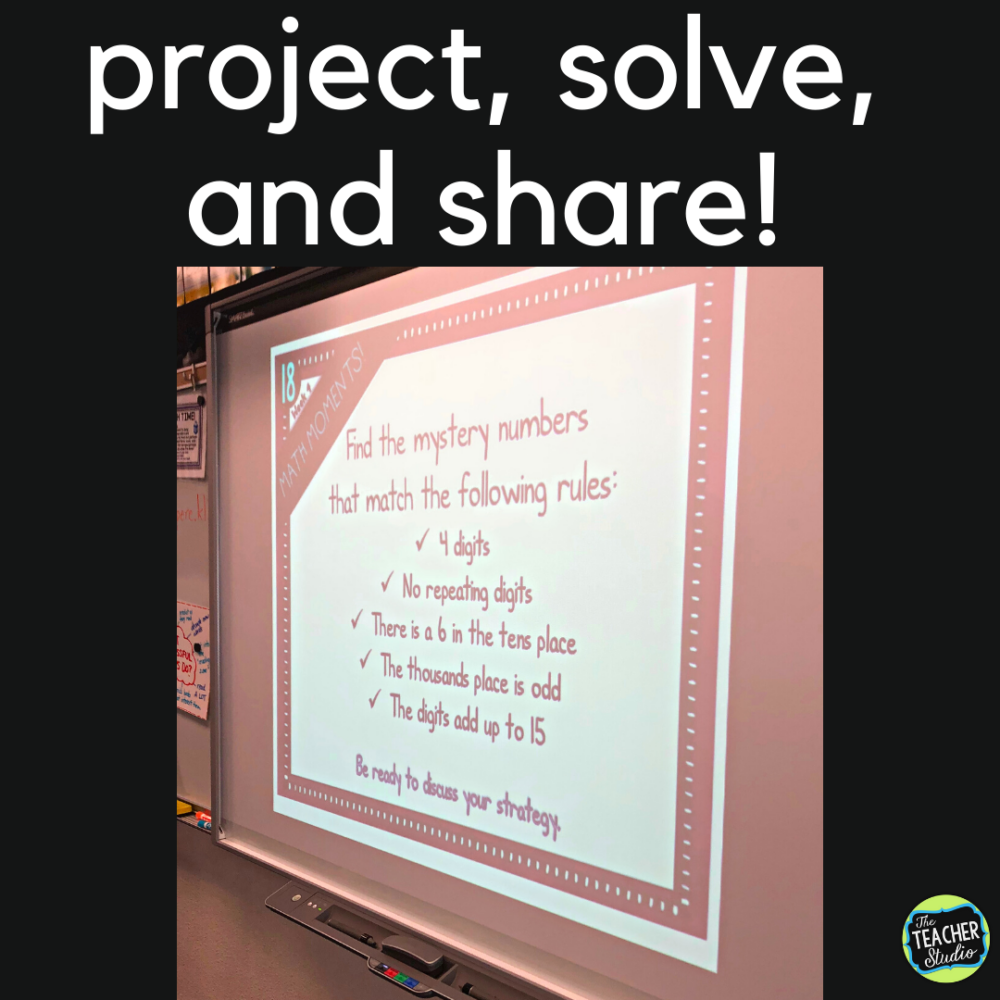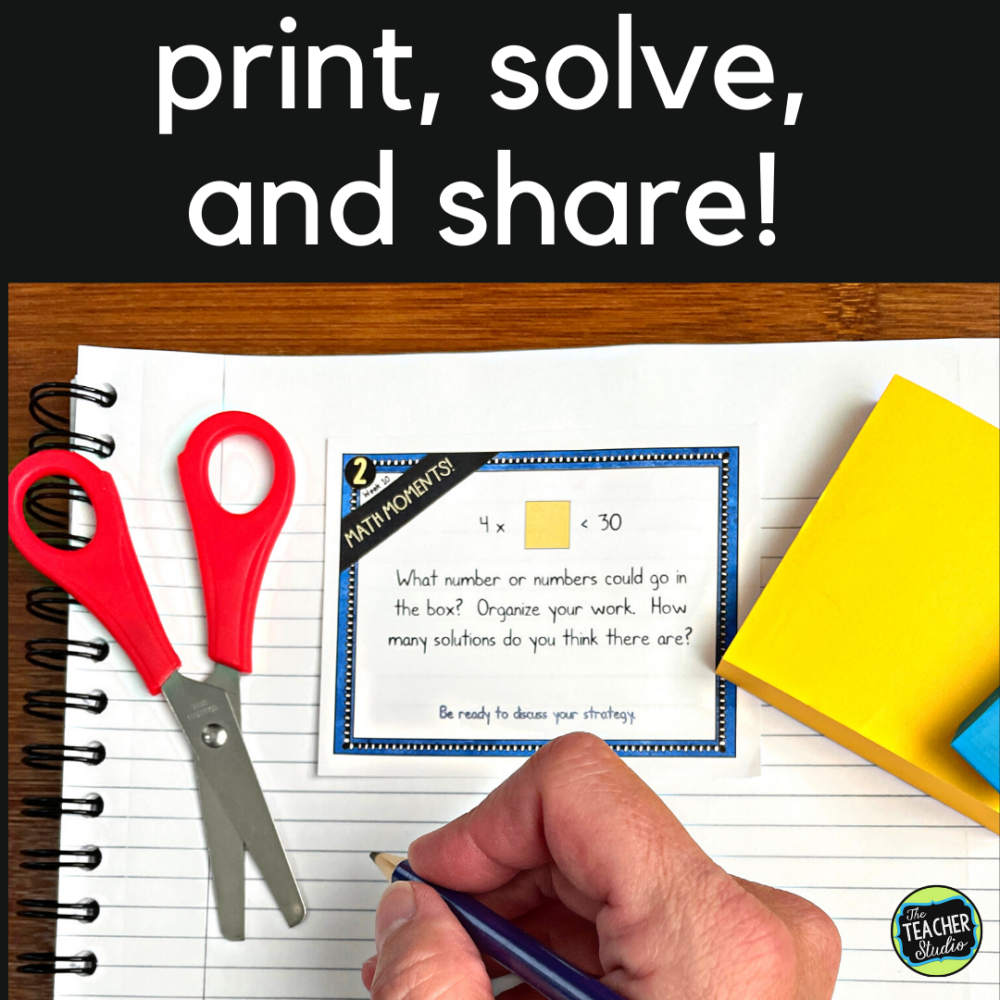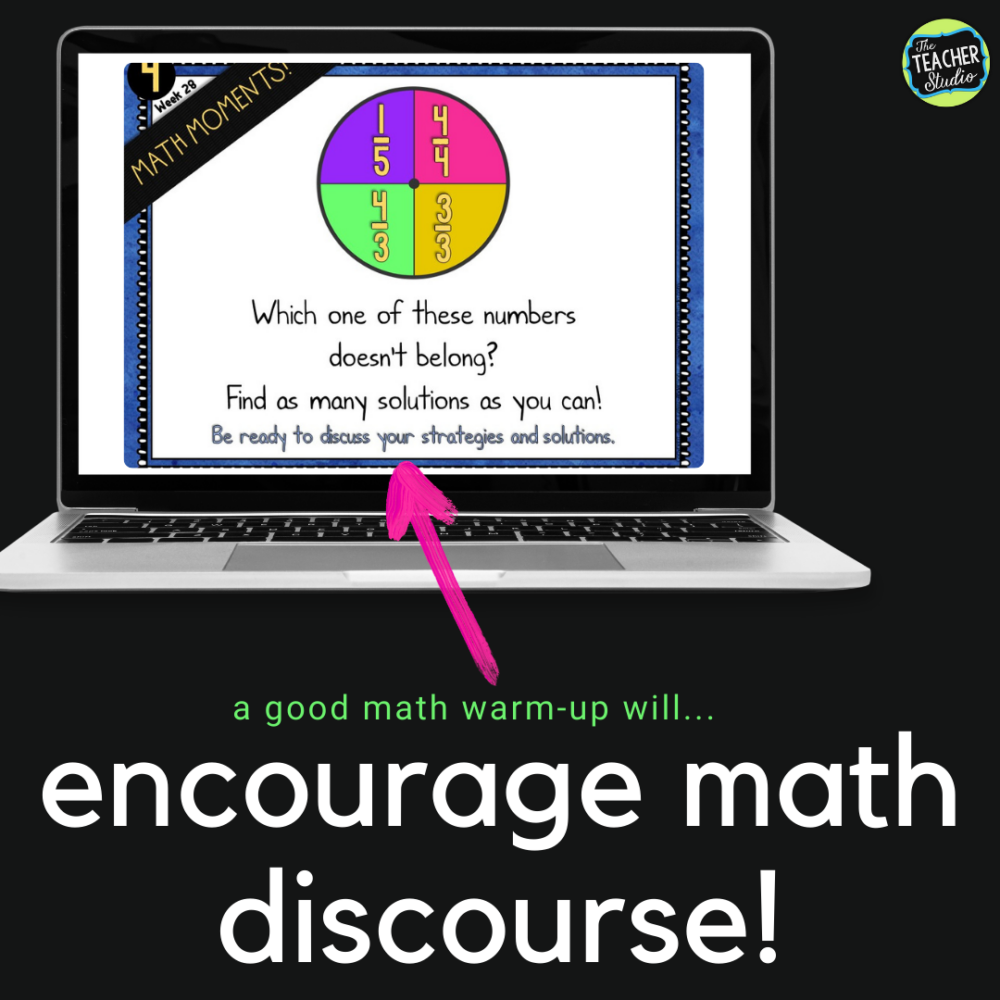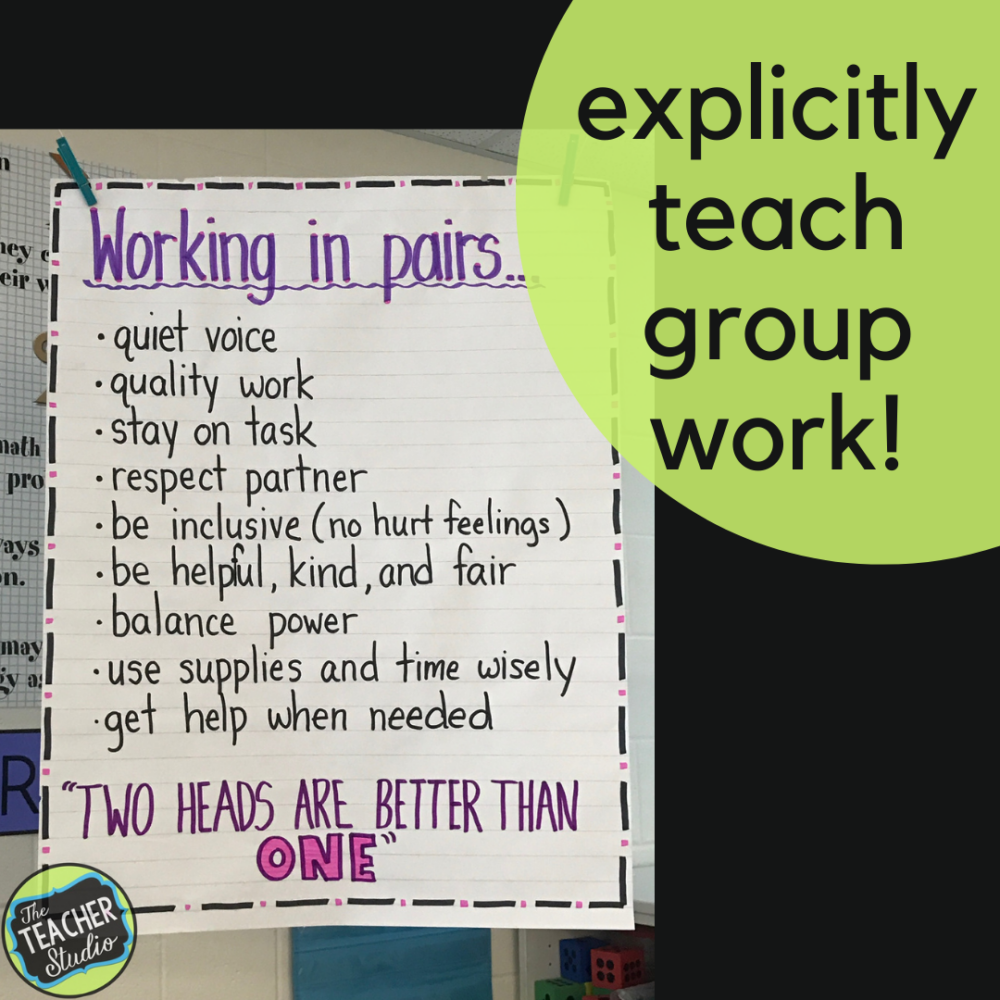How we spend our valuable math minutes is a decision we make every single day. Using math warm-ups to kick off a powerful math class is a tried and true way to activate students’ deep math thinking. Much like an athlete needs to get themselves ready for their workout, using math warm-ups prepares our students to do the “real” work of our lessons.
Sometimes I like to vary how I do these important routines–but the one thing I always do in class is start the day off with a quality math problem to build engagement. We don’t look at homework. There is no passing out papers. We don’t turn to a workbook page. Instead, we dig into a problem that invites thinking and discussion. Let’s look into the different ways we can do just that!
“Study findings suggest that learning of new content is supported by activating a conceptually relevant prior-knowledge sequence that helps connect the prior knowledge with the new knowledge.”
—Pooja G. Sidney and Martha W. Alibali
Ways to use math warm-ups
1. Project, solve discuss
One of the easiest ways to quickly (read “low prep”!) ways to incorporate math warm-ups is to simply project a problem/task onto a screen, let students solve it, and then discuss. This can be done in tons of different ways.
Whole class:
Having a whole-class discussion is a great way to build common language and exposure to different problem types. This is a great way to explicitly coach students on how to work, share, and explain their thinking. This allows you to present information you want all students to have in an efficient way. There are issues with any whole-class instruction, as you know. It is impossible to have tasks that are the perfect fit for every learning style and level. Any given warm-up will be too rigorous for some and too simplistic for others.
When you use this technique, consider how you can meet those differing needs. Do you need to scaffold for your less-experienced problem solvers? Might they need additional tools such as manipulatives or calculators? Could there be an “if you finish early…” problem for those who are speedy? Perhaps you can ask them to solve the problem a second way.
The biggest issue with whole-class work of any kind is engagement, so make sure you are finding ways to get all students connected to the task. We don’t want to have one-third of our class checking out during this super valuable time!
Small groups:
One way to avoid some of these pitfalls is to present the task to the whole class but to have small groups work together. Whether this be simply at desk groups or predetermined groupings (maybe deliberately heterogeneous or perhaps leveled by the amount of scaffolding needed), giving students the chance to talk about the math can keep them engaged and learning from each other. I do always encourage some quick “think time” before having students work in groups so everyone has something to contribute. As the small groups work, circulate and listen, clear up misconceptions, coach, and listen for cool things to share when you come back to the whole group! (Do make sure you come back to the whole group–then everyone gets the benefit of the work that was done.)
Partner solving
This is perhaps even a BETTER strategy–especially at the beginning of the year. I do spend a LOT of time working on partnering skills–not just at the beginning of the year, but all year long. Learning how to give and take, ask questions, ask for clarification, give encouragement, and stay focused are such valuable life skills. Using math warm-ups in pairs is a great way to practice!
2. Send digitally
Now, if you are wanting each student to get their paws on the warm-ups on their own devices, sending them virtually is a great idea! There are a few benefits to this:
- You can engage students as the warm-up is right in front of them.
- If a student is absent, they can still be a part of the learning. This has become increasingly important in recent years!
- If you have students record their ideas virtually, teacher feedback can be quick and easy.
I still think it is critical that we acknowledge the power of “math talk” and discourse. If students DO do a math warm-up digitally, I highly encourage you to still consider the ways you can use whole class, small group, or partner discourse as a part of the process.
3. Printable
Using printable warm-ups is another great way to get students involved with the problem right in front of them. I like to use spiral notebooks for this purpose. Students can simply glue in their warm-up, do their work directly in their notebook, and then be ready to share.
This is a super way to work on showcasing organized work, working on helping students with precision and labeling their work. By sharing under a document camera, students can see a variety of strategies and organizational styles. It’s also a great way for you to showcase students who may not be willing to share aloud.
Another benefit to using math warm-ups in a printable form is that you can track progress over time. students can look back at earlier work, set goals, see improvement, and celebrate successes! If you use spiraled problems, they can also reflect on how much NEW math they have learned through the year and to see the progress they have made.
Other Ideas for Incorporating Math Warm-Ups Into Your Day
Interventions: Consider using warm-up problems at a lower grade level (or from earlier in the year) as a part of an intervention group. Students who sometimes “check out” during whole-class instruction NEED a small group to get and stay engaged. Find the level that is just right–and help coach them through the math that will build their confidence and help them grow.
Revisit old problems: One thing I like to do is notice when a problem gives my class a challenge. I save it and repeat it later in the year. This helps me watch for student growth and to catch continued misunderstandings. This is also a great way to “spiral” instruction and see if students who understood a concept earlier in the year still do!
Power of discussion: As I mentioned earlier, starting every math class with a powerful math discussion is a great way to build engagement. Finding the type of problem that nurtures this discourse isn’t always easy, but it is SO worth it. Remember to explicitly TEACH how to do this. CLICK HERE to read a post with some great ways to do that!
Working on organizing work: One thing that has happened over the years as many math series have moved to workbooks is that students get very used to filling in the blanks, but not organizing their work in a notebook or on blank paper. This truly is a skill, and by using a math warm-up, you have the opportunity to teach them how to do this. From skipping lines between problems to circling/highlighting their answer to labeling their work accurately. many students need to be coached on how to organize their work.
This is a critical part of addressing the precision standard and setting students up to be successful mathematicians. They need to be able to track their own work process, share their thinking, and be able to proofread and find errors. This is a perfect time to work on these essential skills! Remember, you may need to do tons of modeling of YOUR processes along the way.
Where Do I Find Math Warm-Ups?
This part depends on how hard you want to work! I’ve listed a few places to get math warm-ups. You find what works best for you!
- Write your own! This can be great because you can totally customize them to your class. You can use student names and interests and get super high engagement. The cons? Of course–TIME! This does take time and it’s best to find a way to record what skills/strategies you are working on so you build all year long. Remember, we want deep thinking–not simplistic, “right there” problems.

- Look at your math series. Are there problems you aren’t using? Does your program have a warm-up built in? Do you have enrichment problems that might be getting overlooked?
- Use math tests and other work from the past and create similar problems, especially if your students struggled on a given problem type.
- Find teachers who have done the work for you! Seriously–I spent so much time writing my own problems at different levels! It only made sense for me to start to organize it to help others.
Need some help?
If you are interested in checking out MY math warm-up collections (for grades 3, 4, and 5), check the links below. There’s even a free week available for each grade level if you want to give them a try. Again, I’ve worked to take the “spiral” concerns out of your mind and have made sure to tackle ALL the standards at each grade level–including the Standards for Mathematical Practice!
Want to read more about using math warm-ups? CLICK HERE!

